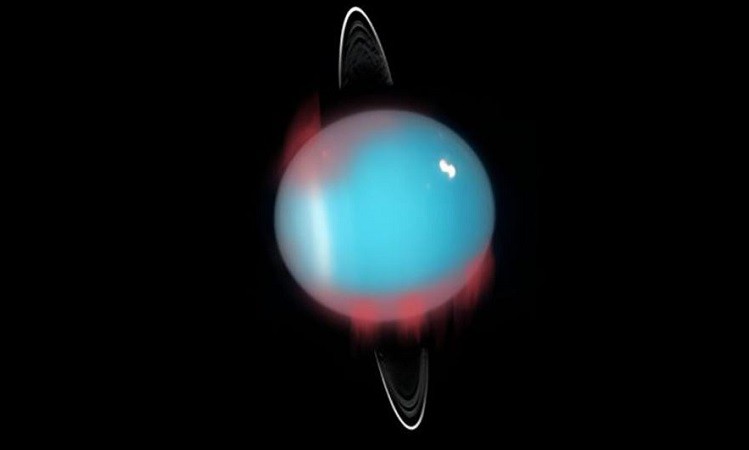
In a major astronomical study, researchers have observed infrared aurorae on the enigmatic planet Uranus for the very first time. The detection of these ethereal phenomena sheds new light on the hidden secrets of this distant gas giant and may offer vital clues about its unusual magnetic field and atmospheric properties.
Traditionally, a planet's heaviest and most dense materials accumulate in its core, giving rise to a powerful, spinning core that generates substantial magnetic fields. These magnetic fields serve as protective barriers in the form of magnetospheres, capable of trapping energetic particles originating from the Sun. As these solar particles journey along magnetic field lines and interact with the planet's atmosphere, they manifest as dazzling polar light displays known as aurorae. While these captivating light shows have been previously witnessed on Earth, Saturn, and Jupiter, they have now graced Uranus with their presence.
The specific colors—or, more technically, wavelengths—of these aurorae are dictated by the unique atmospheric composition of each celestial body. Previously, researchers had identified ultraviolet aurorae on Uranus as far back as 1986. However, it is only now, after almost three decades of investigation beginning in 1992, that astronomers have succeeded in detecting elusive infrared aurorae on this distant ice giant.
Uranus and its cosmic neighbor, Neptune, stand out as peculiar entities in our solar system due to the fact that their magnetic fields do not align with the axes of their rotational spins. The reasons for this intriguing deviation remain a mystery to scientists. The newfound infrared aurorae on Uranus present an exciting opportunity to unravel some of these celestial conundrums.
Uranus's atmosphere is predominantly composed of hydrogen and helium, which is the key to the existence of infrared aurorae on the planet's surface. This discovery not only deepens our understanding of Uranus but also carries broader implications. It provides scientists with essential insights into the compositions of distant exoplanets, facilitating assessments of the potential habitability of ice worlds throughout the universe.
Surprisingly, Uranus and Neptune exhibit higher temperatures than anticipated, considering their primary source of heat is sunlight. Researchers now suspect that these aurorae might be a crucial component in heating these planets, channeling energy deeper into their atmospheres. These groundbreaking findings have been published in the esteemed journal Nature Astronomy.
Lead author of the research paper, Emma Thomas, explained, "The majority of exoplanets discovered to date fall into the sub-Neptune category, sharing physical characteristics similar to Neptune and Uranus. This similarity may extend to their magnetic and atmospheric properties as well. By delving into the intricacies of Uranus's aurorae, which directly connect to the planet's magnetic field and atmosphere, we gain invaluable insights into the atmospheres and magnetic fields of these distant worlds, ultimately aiding our evaluation of their potential for hosting life."
ISRO's Innovative POEM Platform Receives Overwhelming Response
Indian Air Force Bids Farewell to OORIALS MiG-21 Fighter Squadron